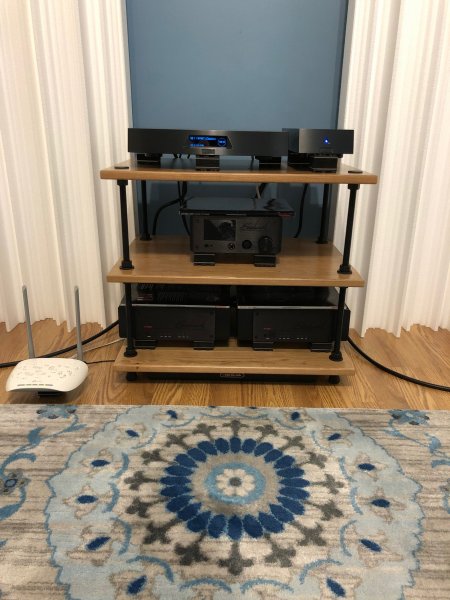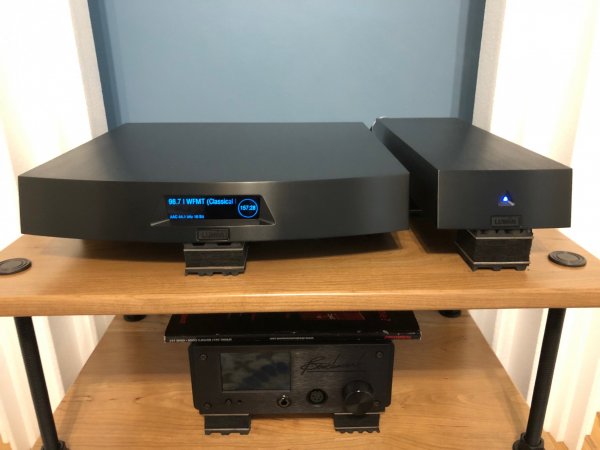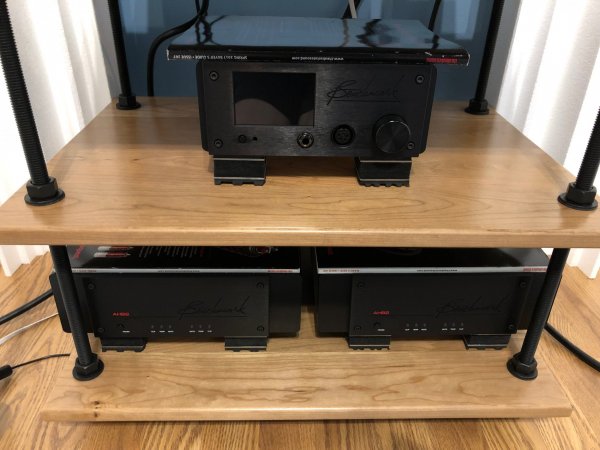My Goals for an Equipment Rack
I'm not pretending that this is the best rack out there in any category. But it happens to meet my needs and seems to me to represent an excellent balance of price versus performance.
For my purposes an audio equipment rack should:
- provide a stable platform for electronics, as in not being subject to rocking and being able to safely hold the weight of your components;
- allow easy physical access to all sides of the components on the rack;
- have easily levelable shelves;
- accommodate and work well with accessory/aftermarket vibration-reducing products;
- be reasonably attractive;
- have low apparent high frequency resonance or ringing when tapped; and
- be low enough in height to stay out of the way of the direct reflections from midrange and tweeter drivers as seen from the listening position.
Why a Low Rack Is Best for Me
Most of those desiderata should be clear enough except, perhaps for the last one. Long experience with audio room set up has made me a believer in the importance of getting the left and right sides of the room (as referenced by the positions of the stereo speakers) to be as close to mirror images of each other as possible. This helps create the best possible spatial presentation from stereo recordings both in terms of imaging and staging.
Both for expense and sonic reasons, I also find it best to avoid long runs of any kind of cable, be it analog, digital, interconnect, speaker, or power. In my smallish room, the only place for the equipment rack which keeps the left and right sides of the room reasonably the same acoustically and keeps the cable runs all fairly short is to put the rack between and behind the two speakers.
Mapping the reflection points of the speakers as viewed from the listening position using a small flat mirror placed against the wall or against any side of components mounted on a rack centered on that wall will usually show that this area behind and between the speakers near the center of the room is not a spot of first reflection. However, experience has taught me that for the most solid center imaging it is best to keep the equipment rack shelves low enough so as not to be at ear/eye level when in the listening position. Whether this is an acoustical effect or is also at least partially a psychoacoustical effect, it seems that a blank wall space is best for the center, rather than the chasses of electronics or the shelves of a rack.
While there are racks which can accommodate massive built-in or placed-atop passive or active suspension tables, such racks get very tall or wide with even a few shelves. If the rack is more than about 30 inches wide, then in my room and many others a centered rack may occupy part of the area of first reflection of parts of the speaker on the wall behind the speakers as viewed from the listening position when the speakers are placed so as to subtend the standard 60-degree angle as viewed from the listening position. Thus, if a rack is constructed in two side-by-side sections so as to keep each tier lower, parts of the rack and components on it will most likely occupy the first-reflection positions of the speakers on the wall behind them as viewed from the listening position.
An alternative is to place all the components on or very near the floor, suspending them on nothing higher than a so-called amp rack, just a few inches high. I have tried that in the past and sonically it can be a truly excellent solution. The problems with such arrangements are that you soon run out of floor space; they create a "messy" appearance in the listening room; they tend to need some longer runs of cabling; they involve a lot of bending to operate controls, insert discs, etc.; and they make physical navigation to gain access to the operating controls or rear panels of components a bit dicey as you attempt to avoid stepping on components or cables.
Another alternative is to use one or two such low stands and just stack multiple components atop each other. I've tried that sort of arrangement also. In some instances, with equipment having very sturdy casework, such as with amp stacks (e.g., four Bryston 7B-SST amps in a stack) it can work well indeed without hell to pay in terms of electromagnetic interference or excessive heat build up. However, such stacking is not optimal if your set up goals include maximally isolating each component from internally and externally induced vibrations. In addition, less sturdy components must be sited toward the top of a stack.
The best solution I've found for this room is to keep the electronics as simple as possible, reducing to a minimum the number of chassis boxes needed, and then using a single sturdy rack to hold the electronics, mechanically isolating each component from the rack with the properly specified aftermarket footers, my current favorite being the A/V RoomService EVPs. This short Salamander Designs Archetype 2 rack meets this goal very well.
Here are a few pictures showing the assembled rack loaded with my equipment. The post which follows discusses my hints on how best to assemble this rack.
Attachments
Last edited:




